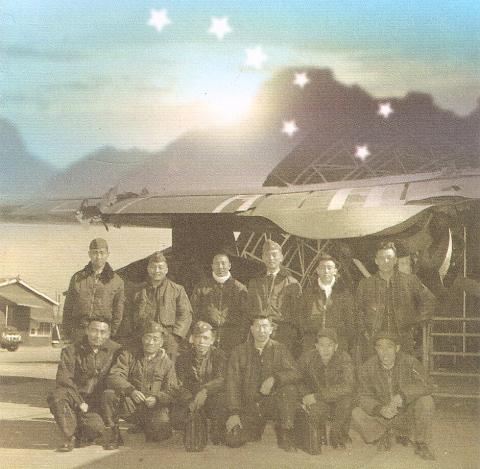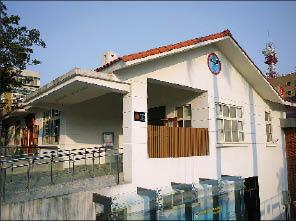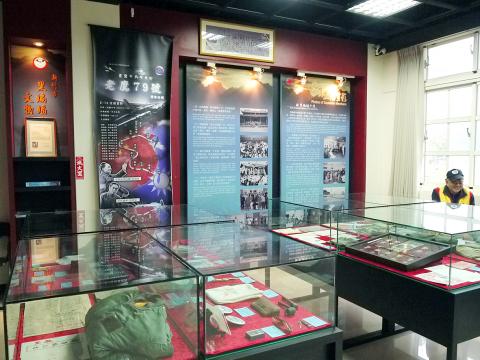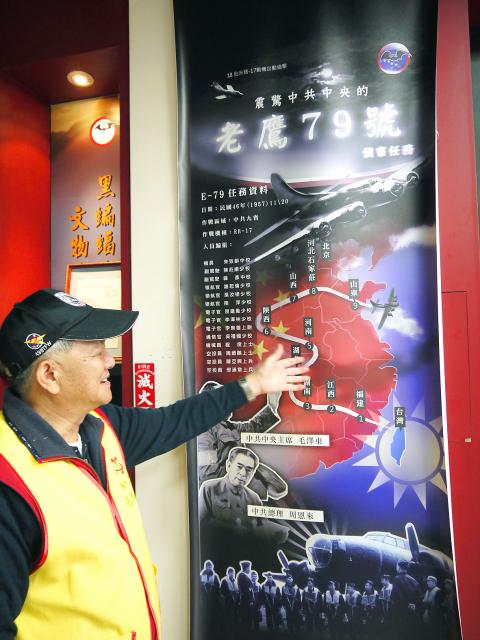A white house with a sloping roof is situated directly opposite the Performance Hall of Hsinchu City’s Bureau of Cultural Affairs. Whenever the performance hall is bustling with people attending some performance, the house appears even quieter than normal. The house, filled with the traces of history so critical to Taiwan’s current prosperity, is the Hsinchu City Black Bat Squadron Memorial Hall, founded on Nov. 22, 2009. The hall showcases a collection of the 34th Air Force Squadron, better known as the “Black Bat Squadron,” and records the sacrifices and the moving stories of this group of martyrs. Even more interestingly, the roughly 140-ping (463m2) building — which is modeled on the dormitory of the US Military Assistance Advisory Group (MAAG) — is built on the original site of the squadron’s Hsinchu camp.
In the 1950s and 1960s, Taiwan experienced a shortage of supplies and tensions ran high in the Taiwan Strait, and it was in desperate need of US aid. In addition to the Soviet Union, the US also saw China as the country posing the greatest threat to the free world. In 1951, MAAG initiated an intelligence project with Taiwan, providing military consultation and military training assistance. In 1952, US military, under the name of Western Enterprise Inc to cover up the cooperation with Taiwan, formed a “Special Ops Squadron” at the Taoyuan airbase. After the Korean War ended in 1953, the squadron moved to Hsinchu and became “Air Force Special Ops Squadron.” In addition to carrying out airdrop missions over China, it was responsible for US-directed covert operations and intelligence gathering on Communist China. Each 14-member crew conducted night missions, flying over China at dangerously low altitudes to gather information on the People’s Liberation Army’s radar system. At the early stages, their work mainly involved airdrops of propaganda materials, supplies and operatives. In 1956, they began conducting electronic reconnaissance and psychological warfare airdrop missions. During special ops, the Black Bat could reach as far north as China’s Northeast, as far west as Gansu, Qinghai, and Yunnan provinces, and as far south as Thailand, Myanmar, and Laos.
In 1957, the P2V-7U patroller (Neptune) was introduced from the US. This stage was the peak of the squadron’s special ops and it was also the time when the most casualties occurred. Among the seven P2V-7U reconnaissance aircraft, five were shot down, killing 68 crewmembers. The P2V-7U, P-3A, and the C-123 were the squadron’s primary aircraft, and there were also various bombers converted to reconnaissance aircraft, such as RB-17. The US also used the squadron’s missions to test the performance of these aircraft. A common characteristic of all these aircraft was that they were not armed; hence, if engaged by enemy aircraft, they could only evade danger through electronic interference and advanced flying techniques at high speeds.

Photo: Lin Ya-ti, Taipei Times
照片:台北時報林亞蒂
A documentary showed at the exhibition hall shows the respect of former “Black Bats” for their main coordinator, then-Air Force Intelligence Administration chief general I Fu-en, who was also the pilot who brought Chiang Kai-shek on his retreat to Taiwan on Dec. 10, 1949 and the founder of China Airlines. The Black Bat members regarded him as their “common boss.” Maybe only those who were deeply involved in that period of history could fully understand their sentiment.
Eighty-four-year-old Colonel Li Chung-shen, former Black Bat electronics officer, currently lives near the Black Bat Squadron Memorial Hall in Hsinchu. He served in the squadron from 1956 until the dismissal of the squadron in 1973. Li said in an interview with the Taipei Times on Thursday that the Black Bat Squadron successfully raised Taiwan’s international status. Li also mentioned the E-79 reconnaissance mission carried out in 1957, which shocked the Chinese Communist Party. He was a part of the crew on the RB-17 reconnaissance aircraft. Even while being engaged by 18 sorties of Communist China’s MiG-17 fighter jets, the group was still able to fly through nine provinces in China and gather information on China’s radar system. The incident made Mao Zedong feel embarrassed and angry. Visitors to the exhibition can sometimes listen to Li talk in detail about the history of “Black Bat Squadron” in person.
In 1958, the official call sign of “34th Air Force Squadron” was adopted. In the same year, Li and other members jointly designed the Bat Squadron Emblem, which has a bat for its main motif. In addition to the squadron’s similarity to bats living by night, the bat wings symbolize the ambition to break through the iron curtain. Underneath the bat is the Big Dipper, signifying navigation. The combination of three large and four small stars indicates the 34th Squadron. Between 1952 and 1972, the squadron lost a total of 15 aircraft and 148 men. In other words, the Black Bat Squadron could be called Taiwan’s earliest special ops unit and the special ops unit with the greatest number of casualties. Two years ago all the members who were killed in action were entered into the Martyrs’ Shrine, a way of remembering these heroes and recognizing their spirit of risking their lives for the nation.
(LIN YA-TI, TAIPEI TIMES)

Photo: Lin Ya-ti, Taipei Times
照片:台北時報林亞蒂
新竹市文化局演藝廳正對面,有棟斜屋頂的白色館舍,每當演藝廳帶給大批民眾藝文饗宴與歡樂時,這棟白屋更顯清幽,其所蘊藏的歷史軌跡,對台灣今日的繁榮,可說功不可沒:它就是二○○九年十一月二十二日成立的「新竹市黑蝙蝠中隊文物陳列館」。館內珍藏犧牲最慘烈的空軍單位—「空軍第三十四中隊」,又稱「黑蝙蝠中隊」—並記錄這群出生入死烈士可歌可泣的故事。以美國軍事援助技術團(簡稱美軍顧問團)宿舍外觀打造約一百四十坪的這棟館舍,就座落在中隊新竹營區原址,別具意義。
在台灣物資普遍缺乏且台海情勢緊張的五○與六○年代,亟需美援,而美國視中共為蘇聯之外,對自由世界威脅最大的國家。一九五一年美軍顧問團與台灣合作展開情資工程,提供軍事諮詢並協助國軍培訓。一九五二年美軍以民間「西方公司」為掩護與台灣合作,在桃園基地成立「特種作戰部隊」,隔年韓戰結束後,改以新竹為基地,並改名為「空軍特種任務組」。除了空投心戰任務外,十四人為單位的組員,晝伏夜出,以極危險的低空飛行,蒐集解放軍雷達情報,展開美國主導對中共情報蒐集與祕密行動。「黑蝙蝠中隊」早期以空投宣傳品、物資及特工人員為主;一九五六年開始進行電子偵測及心戰空投任務。特種作戰期間,足跡北至東北,西至甘肅、青海、雲南,南至泰國、緬甸、寮國。
一九五七年由美方引進P2V-7U海神式Neptune巡邏機,此階段是該中隊從事特種任務的最高峰,也是犧牲最慘重的時期,改裝的七架P2V-7U電子偵察機中,五架遭擊落,共有六十八名隊員殉職。除了以P2V-7U、P-3A與C-123為主要機型,還有各式轟炸機改裝的像是RB-17等偵察機。美方也藉由這些任務的進行,測試這些飛機的功能。這些飛機共通點是無武裝,所以遇到敵機攻擊,只能靠電子干擾以及高超的飛行技術,才能脫險。

Photo: Lin Ya-ti, Taipei Times
照片:台北時報林亞蒂
經由館內所播放的影片,可見昔日隊員人員對於曾經指揮「黑蝙蝠中隊」的空軍情報署長衣復恩—載著蔣中正於一九四九年十二月十日退守台灣的機師,也是華航創辦人—的崇敬,甚至視他為「共同的老大」,這份情懷,可能要深入這段歷史的人,才能體會。
高齡八十四歲且擔任「黑蝙蝠中隊」電子官的退役上校李崇善,目前住在「新竹市黑蝙蝠中隊文物陳列館」附近,他自一九五六年起進入中隊服務至一九七三年黑蝙蝠解散。李上校週四向《台北時報》表示,「黑蝙蝠中隊」成功提升台灣在國際的地位。他也提到一九五七年一場震驚中共中央的老鷹七十九號偵察任務,他個人當時就在RB-17偵察機上,即便中共出動十八批米格十七戰機,「黑蝙蝠中隊」還是飛經中國九省蒐集雷達情資,成功完成任務;此事件也讓毛澤東感到丟臉與氣憤。民眾有時也能見到李上校在館內親自為民眾詳盡講述這段歷史。
「黑蝙蝠中隊」一九五八年正式對外使用「空軍第三十四中隊」番號。同年,李上校與其他同仁聯手設計一個以蝙蝠為主體的蝙蝠隊徽,除了蝙蝠是夜行動物外,其翅膀有衝破鐵幕的象徵。蝙蝠下方的北斗七星代表航行,三大四小象徵第三十四中隊。一九五二年至一九七二年間,總計損失飛機十五架,犧牲作戰人員一百四十八名隊員,堪稱時間最早,犧牲最慘烈的特種部隊。全部殉職隊員已於兩年前入忠烈祠,感念這些英雄犧牲小我完成大我的付出。
(台北時報記者林亞蒂)

Photo: Lin Ya-ti, Taipei Times
照片:台北時報林亞蒂

Photo: Lin Ya-ti, Taipei Times
照片:台北時報林亞蒂

A ‘Dutch angle’ is a classic camera technique that has been used in filmmaking since the 1920s, when it was introduced to Hollywood by German Expressionists. Why is it called the Dutch angle if it’s actually German? In fact, it has no __1__ to the Netherlands. The term “Dutch” is widely believed to be a misinterpretation of “Deutsch,” which means German in the German language. In any event, the name stuck, and the Dutch angle remains a popular cinematic tool to this day. This technique involves tilting the camera on its x-axis, skewing the shot to create a sense of

A: After “God of Songs” Jacky Cheung sang for late singer Khalil Fong recently, music streaming service KKBOX also paid tribute to Fong by releasing his greatest hits online. B: The 20th KKBOX Music Awards ceremony is taking place at the K-Arena in Kaohsiung tomorrow. Fong performed at the ceremonies in the past. A: Who are the performers this year? B: The performers include Taiwanese groups 911, Wolf(s), Ozone, Singaporean pop diva Tanya Chua, and K-pop group Super Junior. A: South Korean stars actually took four spots among KKBOX’s 2024 Top 10 singles, showing that K-pop is still

Historians are rethinking the way the Holocaust is being presented in museums as the world marks the 80th anniversary of the liberation of the last Nazi concentration camps this month. Shocking images of the mass killings of Jews were “used massively at the end of World War II to show the violence of the Nazis,” historian Tal Bruttmann, a specialist on the Holocaust, told AFP. But in doing so “we kind of lost sight of the fact that is not normal to show” such graphic scenes of mass murder, of people being humiliated and dehumanized, he said. Up to this

Dos & Don’ts — 想想看,這句話英語該怎麼說? 1. 能做的事都做了。 ˇ All that could be done has been done. χ All that could be done have been done. 註︰all 指事情或抽象概念時當作單數。例如: All is well that ends well. (結果好就是好。) All is over with him. (他已經沒希望了。) That’s all for today. (今天到此為止。) all 指人時應當作複數。例如: All of us are interested in his proposal. All of us are doing our best. 2. 我們這麼做有益於我們的健康。 ˇ What we are doing is good for our health. χ What we are doing are good for our health. 註︰以關係代名詞 what 引導的作為主詞的子句,動詞用單數。如: What he said is true. 3. 大家都沿著步道跑。 ˇ Everybody runs along the trail. χ Everybody run along the trail. 註︰everyone 是指一大群人,但在文法上一般用單數。 4. 桌上有一本筆記本和兩支筆。 ˇ There were two